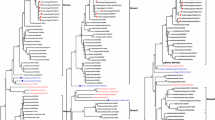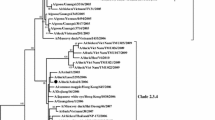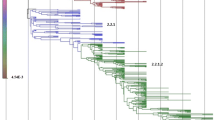Abstract
Highly pathogenic avian influenza (HPAI) virus of the H5N1 subtype was first diagnosed in poultry in Egypt in 2006, and since then the disease became enzootic in poultry throughout the country, affecting the poultry industry and village poultry as well as infecting humans. Vaccination has been used as a part of the control strategy to help to control the disease. Epidemiological data with sequence analysis of H5N1 viruses is important to link the mechanism of virus evolution in Egypt. This study describes the evolutionary pattern of Egyptian H5N1 viruses based on molecular characterization for the isolates collected from commercial poultry farms and village poultry from 2006 to 2011. Genetic analysis of the hemagglutinin (HA) gene was done by sequencing of the full-length H5 gene. The epidemiological pattern of disease outbreaks in Egyptian poultry farms seems to be seasonal with no specific geographic distribution across the country. The molecular epidemiological data revealed that there are two major groups of viruses: the classic group of subclade 2.2.1 and a variant group of 2.2.1.1. The classic group is prevailing mainly in village poultry and had fewer mutations compared to the originally introduced virus in 2006. Since 2009, this group has started to be transmitted back to commercial sectors. The variant group emerged by late 2007, was prevalent mainly in vaccinated commercial poultry, mutated continuously at a higher rate until 2010, and started to decline in 2011. Genetic analysis of the neuraminidase (NA) gene and the other six internal genes indicates a grouping of the Egyptian viruses similar to that obtained using the HA gene, with no obvious reassortments. The results of this study indicate that HPAI-H5N1 viruses are progressively evolving and adapting in Egypt and continue to acquire new mutations every season.










Similar content being viewed by others
Abbreviations
- AIV:
-
Avian influenza virus
- HA:
-
Hemagglutinin
- HPAI:
-
Highly pathogenic avian influenza
- RBD:
-
Receptor binding domain
- AS:
-
Antigenic site
References
Abdel-Moneim AS, Shany SA, Fereidouni SR, Eid BT, el-Kady MF, Starick E, Harder T, Keil GM (2009) Sequence diversity of the haemagglutinin open reading frame of recent highly pathogenic avian influenza H5N1 isolates from Egypt. Arch Virol 154:1559–1562
Abdelwhab EM, Selim AA, Arafa A, Galal S, Kilany WH, Hassan MK, Aly MM, Hafez MH (2010) Circulation of avian influenza H5N1 in live bird markets in Egypt. Avian Dis 54(2):911–914. doi:10.1637/9099-100809
Aly MM, Arafa A, Hassan MK (2008) Epidemiological findings of outbreaks of disease caused by highly pathogenic H5N1 avian influenza virus in poultry in Egypt during 2006. Avian Dis 52:269–277
Arafa A, Suarez DL, Hassan MK, Aly MM (2010) Phylogenetic analysis of HA and NA genes of HPAI-H5N1 Egyptian strains isolated from 2006 to 2008 indicates heterogeneity with multiple distinct sublineages. Avian Dis 54:345–349
Auewarakul P, Suptawiwat O, Kongchanagul A, Sangma C, Suzuki Y, Ungchusak K, Louisirirotchanakul S, Lerdsamran H, Pooruk P et al (2007) An avian influenza H5N1 virus that binds to a human-type receptor. J Virol 81:9950–9955
Bragstad K, Jørgensen PH, Handberg K, Hammer AS, Kabell S, Fomsgaard A (2007) First introduction of highly pathogenic H5N1 avian influenza a viruses in wild and domestic birds in Denmark, Northern Europe. Virol J 11(4):43
Cattoli G, Monne I, Fusaro A, Joannis TM, Lombin LH, Aly MM, Arafa AS, Sturm-Ramirez KM, Couacy-Hymann E, Awuni JA, Batawui KB, Awoume KA, Aplogan GL, Sow A, Ngangnou AC, El Nasri Hamza IM, Gamatie D, Dauphin G, Domenech JM, Capua I (2009) Highly pathogenic avian influenza virus subtype H5N1 in Africa: a comprehensive phylogenetic analysis and molecular characterization of isolates. PLoS One 4:e4842
Cattoli G, Milani A, Temperton N, Zecchin B, Buratin A, Molesti E, Aly MM, Arafa A, Capua I (2011) Antigenic drift in H5N1 avian influenza in poultry is driven by mutations in major antigenic sites of the hemagglutinin molecule analogous to human influenza. JVI Accepts, published online ahead of print on 6 July 2011 J. Virol. doi:10.1128/JVI.02403-10
Chen H, Smith GJD, Zhang SY, Qn K, Wang J, Li KS, Webster RG, Peiris JS, Guan Y (2005) Avian flu: H5N1 virus outbreak in migratory waterfowl. Nature 436:191–192
Chen GW, Chang SC, Mok CK, Lo YL, Kung YN et al (2006) Genomic signatures of human versus avian influenza a viruses. Emerg Infect Dis 12:1353–1360
Duvvuri VR, Duvvuri B, Cuff WR, Wu GE, Wu J (2009) Role of positive selection pressure on the evolution of H5N1 hemagglutinin. Genomics Proteomics Bioinformatics 2009(7):47–56
Escorcia M, Vázquez L, Méndez ST, Rodríguez-Ropón A, Lucio E, Nava GM (2008) Avian influenza: genetic evolution under vaccination pressure. Virol J 2008(5):15
Fao (2011) EMPRES transboundary. Anim Dis Bull No. 39, p 39–43 Retrieved from. http://www.fao.org/docrep/015/i2530e/i2530e00.pdf
Felsenstein J (1985) Confidence limits on phylogenies: an approach using the bootstrap. Evolution 39:783–791
Fusaro A, Nelson MI, Joannis T, Bertolotti L, Monne I, Salviato A, Olaleye O, Shittu I, Sulaiman L, Lombin LH, Capua I, Holmes EC, Cattoli G (2010) Evolutionary dynamics of multiple sublineages of H5N1 influenza viruses in Nigeria from 2006 to 2008. J Virol 84(7):3239–3247
Gall-Recule GL, Briand FX, Schmitz A, Guionie O, Massin P, Jestin V (2008) Double introduction of highly pathogenic H5N1 avian influenza virus into France in early 2006. Avian Pathol 37:15–23
Gao Y, Zhang Y, Shinya K, Deng G, Jiang Y et al (2009) Identification of amino acids in HA and PB2 critical for the transmission of H5N1 avian influenza viruses in a mammalian host. PLoS Pathog 5:e1000709
Grund C, Abdelwhab EM, Arafa A, Ziller M, Hassan MK, Aly MM, Hafez MH, Harder TC, Beer M (2011) Highly pathogenic avian influenza virus H5N1 from Egypt escapes vaccine-induced immunity but confers clinical protection against a heterologous clade 2.2.1 Egyptian isolate. Vaccine 29:5567–5573
Ha Y, Stevens DJ, Skehel JJ, Wiley DC (2002) H5 avian and H9 swine influenza virus haemagglutinin structures: possible origin of influenza subtypes. EMBO J 21:865–875
Hafez MH, Arafa A, Abdelwhab EM, Selim A, Khoulosy SG, Hassan MK, Aly MM (2010) Avian influenza H5N1 virus infections in vaccinated commercial and backyard poultry in Egypt. Poult Sci 89:1609–1613. doi:10.3382/ps.2010-00708
Hall TA (1999) BioEdit: a user-friendly biological sequence alignment editor and analysis program for Windows 95/98/NT. Nucl Acids Symp Ser 41:95–98
Hensley SE, Das SR, Bailey AL, Schmidt LM, Hickman HD, Jayaraman A, Viswanathan K, Raman R, Sasisekharan R, Bennink JR, Yewdell JW (2009) Hemagglutinin receptor binding avidity drives influenza a virus antigenic drift. Science 326:734–736
Kayali G, Webby RJ, Ducatez MF, El Shesheny RA, Kandeil AM et al (2011) The epidemiological and molecular aspects of influenza H5N1 viruses at the human-animal interface in Egypt. PLoS One 6(3):e17730. doi:10.1371/journal.pone.0017730
Kaverin NV, Rudneva IA, Ilyushina NA, Varich NL, Lipatov AS, Smirnov YA, Govorkova EA, Gitelman AK, Lvov DK, Webster RG (2002) Structure of antigenic sites on the haemagglutinin molecule of H5 avian influenza virus and phenotypic variation of escape mutants. J Gen Virol 83:2497–2505
Kaverin NV, Rudneva IA, Govorkova EA, Timofeeva TA, Shilov AA, Kochergin-Nikitsky KS, Krylov PS, Webster RG (2007) Epitope mapping of the hemagglutinin molecule of a highly pathogenic H5N1 influenza virus by using monoclonal antibodies. J Virol 81:12911–12917
Kilany WH, Abdelwhab EM, Arafa A-S, Selim A, Safwat M, Nawar AA, Erfan AM, Hassan MK, Aly MM, Hafez HM (2010) Protective efficacy of H5 inactivated vaccines in meat turkey poults after challenge with Egyptian variant highly pathogenic avian influenza H5N1 virus. Vet Microbiol 150(1–2):28–34
Kim J, Kayali G, Walker D et al (2010) Puzzling inefficiency of H5N1 influenza vaccines in Egyptian poultry. Proc Natl Acad Sci. doi:10.1073/pnas.1006419107
Klenk HD, Wagner R, Heuer D, Wolff T (2002) Importance of hemagglutinin glycosylation for the biological functions of influenza virus. Virus Res 82:73–75
Lam TT, Hon CC, Pybus OG, Kosakovsky Pond SL, Wong RT, Yip CW, Zeng F, Leung FC (2008) Evolutionary and transmission dynamics or reassortant H5N1 influenza virus in Indonesia. PLoS Pathog 4:e1000130
Lee CW, Senne DA, Suarez DL (2004) Effect of vaccine use in the evolution of Mexican lineage H5N2 avian influenza virus. J Virol 78:8372–8381
Liu J, Xiao H, Lei F, Qin K, Zhang XW, Zhang XL, Zhao D, Wang G, Feng Y, Ma J, Liu W, Wang J, Gao GF (2005) Highly pathogenic H5N1 influenza virus infection in migratory birds. Science 309:1206
Monne I, Joannis TM, Fusaro A, De Benedictis P, Lombin LH, Ularamu H, Egbuji A, Solomon P, Obi TU, Cattoli G, Capua I (2008) Reassortant avian influenza virus (H5N1) in poultry, Nigeria, 2007. Emerg Infect Dis 14:637–640
Nobusawa E, Aoyama T, Kato H, Suzuki Y, Tateno Y, Nakajima K (1991) Comparison of complete amino acid sequences and receptor-binding properties among 13 serotypes of hemagglutinins of influenza a viruses. Virology 182:475–485
Pfeiffer J, Pantin-Jackwood M, To TL, Nguyen T, Suarez DL (2009) Phylogenetic and biological characterization of highly pathogenic H5N1 avian influenza viruses (Vietnam 2005) in chickens and ducks. Virus Res 142:108–120
Saitou N, Nei M (1987) The neighbor-joining method: a new method for reconstructing phylogenetic trees. Mol Biol Evol 4:406–425
Salzberg SL, Kingsford C, Cattoli G, Spiro DJ, Janies DA, Aly MM, Brown IH, Couacy-Hymann E, De Mia GM, Dung do H, Guercio A, Joannis T, Maken Ali AS, Osmani A, Padalino I, Saad MD, Savic V, Sengamalay NA, Yingst S, Zaborsky J, Zorman-Rojs O, Ghedin E, Capua I (2007) Genome analysis linking recent European and African influenza (H5N1) viruses. Emerg Infect Dis 13:713–718
Shih AC, Hsiao TC, Ho MS, Li WH (2007) Simultaneous 414 amino acid substitutions at antigenic sites drive influenza a hemagglutinin evolution. Proc Natl Acad Sci USA 104:6283–6288
Slomka MJ, Pavlidis T, Banks J, Shell W, McNally A, Essen S, Brown IH (2007) Validated H5 Eurasian real-time reverse transcriptase– polymerase chain reaction and its application in H5N1 outbreaks in 2005–2006. Avian Dis 51:373–377
Spackman E, Senne DA, Myers TJ, Bulaga LL, Garber LP, Perdue ML, Lohman K, Daum LT, Suarez DL (2002) Development of a real time reverse transcriptase PCR assay for type A influenza virus and the avian H5 and H7 hemagglutinin subtypes. J Clin Microbiol 40:3256–3260
Starick E, Beer M, Hoffmann B, Staubach C, Werner O, Globig A, Strebelow G, Grund C, Durban M, Conraths FJ, Mettenleiter T, Harder T (2008) Phylogenetic analyses of highly pathogenic avian influenza virus isolates from Germany in 2006 and 2007 suggest at least three separate introductions of H5N1 virus. Vet Microbiol 128:243–252
Stech O, Veits J, Weber S, Deckers D, Schröer D, Vahlenkamp W, Breithaupt A, Teifke J, Thomas C, Stech J (2009) Acquisition of a polybasic hemagglutinin cleavage site by a low-pathogenic avian influenza virus is not sufficient for immediate transformation into a highly pathogenic strain. J Virol 83(11)
Stevens J, Blixt O, Tumpey TM, Taubenberger JK, Paulson JC, Wilson IA (2006) Structure and receptor specificity of the hemagglutinin from an H5N1 influenza virus. Science 312:404–410
Suwannakarn K, Amonsin A, Sasipreeyajan J, Kitikoon P, Tantilertcharoen R, Parchariyanon S, Chaisingh A, Nuansrichay B, Songserm T, Theamboonlers A, Poovorawan Y (2009) Molecular evolution of H5N1 in Thailand between 2004 and 2008. Infect Genet Evol 9:896–902
Szeleczky Z, Da′n A, Ursu K, Ivanics E, Kiss I, Erde′lyi K, Bela′k S, Muller CP, Brown IH, Ba′lint A (2009) Four different sublineages of highly pathogenic avian influenza H5N1 introduced in Hungary in 2006–2007. Vet Microbiol 139:24–33
Tamura K, Dudley J, Nei M, Kumar S (2007) MEGA4: molecular evolutionary genetics analysis (MEGA) software version 4.0. Mol Biol Evol 24:1596–1599
Vijaykrishna D, Bahl J, Riley S, Duan L, Zhang JX, Chen H, Peiris JS, Smith GJ, Guan Y (2008) Evolutionary dynamics and emergence of panzootic H5N1 influenza viruses. PLoS Pathog 4:10
Watanabe Y, Ibrahim MS, Ellakany HF, Kawashita N, Mizuike R, Hiramatsu H, Sriwilaijaroen N, Takagi T, Suzuki Y, Ikuta K (2011) Acquisition of human-type receptor binding specificity by new H5N1 influenza virus sublineages during their emergence in birds in Egypt. PLoS Pathog 7:19
WHO/OIE/FAO H5N1 Evolution Working Group. (2008) Toward a unified nomenclature system for highly pathogenic avian influenza virus (H5N1). Emerg Infect Dis 14:e1
WHO/OIE/FAO H5N1 Evolution Working Group (2009) Continuing progress towards a unified nomenclature for the highly pathogenic H5N1 avian influenza viruses: divergence of clade 2.2 viruses. Influenza Other Respir Viruses 3:59–62
WHO/OIE/FAO H5N1 Evolution Working Group (2012) World Health Organization/World Organisation for Animal Health/Food and Agriculture Organization. H5N1 Evolution Working Group. 2011. Letter to the editor: continued evolution of highly pathogenic avian influenza A (H5N1): updated nomenclature. Influenza Other Respir Viruses 6:1–5
Xu X, Subbarao K, Cox NJ, Guo Y (1996) Genetic characterization of the pathogenic influenza A/Goose/Guangdong/1/96 (H5N1) virus: similarity of its hemagglutinin gene to those of H5N1 viruses from the 1997 outbreaks in Hong Kong. Virology 224:175–183
Yen H-L, Peiris JSM (2009) Mapping antibody epitopes of the avian H5N1 influenza virus. PLoS Med 6(4):3
Acknowledgments
This work is part of the output of the FAO project, “Vaccine Efficacy for the Control of Avian Influenza in Egypt” (OSRO/EGY/801/USA), implemented in partnership with National Laboratory for Veterinary Quality Control on Poultry Production (NLQP), General Organization of Veterinary Services (GOVS) and South East Poultry Research Laboratory (SEPRL). Laboratory consumables used for the diagnosis of A/H5NI HPAI were obtained from another FAO project “Strengthening Avian Influenza Detection and Response (SAIDR)” (OSRO/EGY/701/USA). Both of these projects were funded by the United States Agency for International Development (USAID). The contents are the responsibility of the authors and do not necessarily reflect the views of USAID or the government of the United States of America. The authors would also like to thank Erica Spackman, Filip Claes, Toni Ettel and the OFFLU network through the Food and Agriculture Organization of the United Nations (FAO) for their diverse technical and administrative assistance during project implementation.
Author information
Authors and Affiliations
Corresponding author
Electronic supplementary material
Below is the link to the electronic supplementary material.
Rights and permissions
About this article
Cite this article
Arafa, A., Suarez, D., Kholosy, S.G. et al. Evolution of highly pathogenic avian influenza H5N1 viruses in Egypt indicating progressive adaptation. Arch Virol 157, 1931–1947 (2012). https://doi.org/10.1007/s00705-012-1385-9
Received:
Accepted:
Published:
Issue Date:
DOI: https://doi.org/10.1007/s00705-012-1385-9




